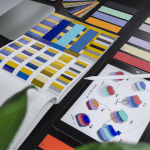A well-developed user experience (UX) and user interface (UI) are critical for capturing user attention. One of the most valuable tools for refining these elements is realistic app mockups. They serve as visual blueprints, enhancing the user experience by providing a tangible representation of the app before full development. They also allow designers to test app concepts through rough prototype tools like Sketch and Adobe XD.
Creating realistic app mockups is a crucial step in the design process, serving as a bridge between initial concepts and the final product. These mockups help ensure aesthetics, functionality, and usability and create an intuitive user experience.
Here are some practical tips for enhancing user experience with realistic app mockups:
Conduct User Research
Before designing app mockups, it’s crucial to understand users through research. Methods like interviews, surveys, and observation provide insights into user behaviors, pain points, and motivations. These findings help ensure that mockups directly address real user needs, leading to an improved experience.
For example, research could show fitness app users want to log workouts from wearables and get personalized nutrition tips quickly. Mockups would then focus on simple workout logging flows and clean nutrition trackers.
To accelerate the mockup process, you could utilize a mockup generator to create initial wireframes based on research findings and proposed user flows. This gives you a strong starting point for higher-fidelity mockups later.
Continue to reference the research findings throughout the design process to ensure you ground decisions in user perspectives. Test mockups with user groups early and iterate depending on feedback. The upfront time investment in research pays off with a design that resonates with users and enhances engagement.
Choose The Right Tool
The tools used to design mockups greatly influence their realism and usefulness. Essential tools like pen and paper enable quick ideation but lack interactivity. Professional tools like Sketch, Adobe XD, and Figma allow for the creation of clickable prototypes with micro-interactions that mimic the behavior of real apps.
For instance, Sketch could provide low-fidelity wireframes to brainstorm core features. You could then use Figma to create high-fidelity mockups with animated menus and transitions for stakeholder reviews.
Consider mockup goals when choosing tools. Will static screens suffice, or is an interactive prototype better for usability testing? Do you need advanced visual capabilities? Outline must-have features like revision history, collaboration, and developer handoff capabilities.
The right tools allow you to add realism through dynamics like hover states, clicks, and scrolling. Using better tools leads to better mockups and enhanced user validation. Strategically select tools for the level of fidelity and interactivity required.
Focus On Visual Design
Visual design significantly impacts the realism of app mockup designs. A polished, professional look signals to users that the app will be of high quality. So, focus on visual details like layout, spacing, typography, colors, and images. Align them with existing brand guidelines or style guides to maintain consistency and follow platform conventions.
For instance, an app for finding nearby hiking trails could use vibrant greens and blues with nature imagery, as well as sans-serif fonts and ample white space to improve scalability. On the contrary, a banking app might opt for conservative colors, graphical accent elements, and serif body text for a traditional feel. Additionally, icons should be recognizable for everyday actions like transfers or deposits.
Careful consideration of visual design elements makes mockups feel polished and ready for launch. This instills confidence in the product vision and enhances user engagement. However, beware of over-designing at the expense of simplicity. Find the optimal balance between aesthetics and usability.
Prioritize Clarity And Simplicity
Realistic app mockups should enable intuitive navigation through a clean, focused design. Users should be able to grasp functionality without feeling overwhelmed. Therefore, it’s crucial to optimize clarity.
Consider highlighting only the key features and flows using wireframes. Use succinct, familiar labels like log in instead of commence user session and employ typical iconography such as a magnifying glass, which denotes search. Also, simplify layouts with ample white space instead of cramming in elements, ensure buttons and menus look clickable, and guide the user journey with clear calls-to-action.
For example, a messaging app mockup may have just three main screens: a list of conversations, a conversation thread, and the new message screen. You could then add optional features like themes or stickers later.
Resist the urge to use excessive text and complex navigation patterns that distract from core tasks. While complete mockups have a place later in development, they initially focus on a simplified perspective of the user experience.
Implement A Responsive Design
Today’s digital experiences span smartphones, tablets, desktops, and more. Users expect a consistent, optimized experience regardless of their device. Responsive design is, therefore, crucial for realistic app mockups. The mockups should illustrate how the interface adapts across screen sizes and orientations.
For instance, a shopping app could show a two-column layout on a desktop while switching to a single optimized column on mobile. Additionally, menu patterns may adapt, using a flyout on mobile versus persistent desktop navigation.
Consider UX testing across various devices to reveal usability issues overlooked on single screens. Responsive mockups demonstrate that the app aligns with multi-device usage habits. They also allow you to create platform-specific versions if needed, like a simplified mobile layout.
By accounting for diverse digital touchpoints, responsive mockups enhance user experience across contexts. They provide a future-proof vision aligned with steadily growing device diversity.
Conclusion
Realistic and well-executed mockups are invaluable for bringing app ideas to life before heavy development. By focusing on the elements discussed, you can create app mockups that delight stakeholders and effectively simulate how users will experience the final product. Thoughtful mockups enhance collaboration, validation, and shared vision on meeting customer needs.
- Exploring the Future of Audio Transcription: AI and Beyond - December 24, 2025
- How Beginners Can Create Professional Logo Packs Using CapCut PC - December 5, 2025
- 5 Ways Creative Design Teams Can Find Fresh Inspiration - December 3, 2025






Recent Comments